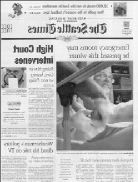PROMISES, PROMISES. The Post-Intelligencer‘s skinny strike-bound edition last week was a “quality newspaper,” pronounced P-I executive editor Ken Bunting. The Seattle Times “will get better and better” until you won’t notice the difference, predicted its president Mason Sizemore. In its very first strike editorial, the Times instantly dubbed its 24-page edition “chock full of information unattainable any other way.”
True—if you’ve been away to Mars, your house lacks TV, radio, or Internet access, and you prefer your news reheated a day later.
Still, Seattle’s strike-bound dailies and their online versions were, in fact, offering journalism you couldn’t get anywhere else, and maybe wouldn’t want to, such as that headline on the Times Web site announcing the walkout last Tuesday morning:
Newspaper Guild strikes Times and P-
After a week’s distribution of mostly canned goods, the papers produced by managers and strikebreakers had fulfilled their lack of promise: wire rewrites, boilerplate, file photos, meager coverage—free, and still overpriced. Even Times executive editor Michael Fancher had to admit in the slimmed-down Sunday Times/P-I (five ounces news, five pounds ads), “It’s hard to imagine how we will ever regain what is being lost.” As exemplars of reporting, the slap-dash results were reminiscent of the aphorism of former P-I artist Ray Collins. He used to interrupt tours of students through the newspaper’s hallways with an explanation of how newsrooms really work:
“Those people over there, they can write but they can’t spell. They’re reporters.
“Those people over there, they can spell but they can’t write. They’re copy editors.
“The guy in the middle? He can’t do either. He’s the managing editor.”
Management-penned/edited pieces at both papers included a buried report on the talk-of-the-town freeway cash spill of $65,000 from a Loomis-Fargo armored car. Times editors published a rewrite about six Guatemalan children claiming to be out-of-wedlock offspring of men killed in the Alaska Airlines flight 261 crash. That news was broken the day before by striking Times investigative reporters Eric Nalder and Susan Kelleher on the strikers’ Web site, UnionRecord.com. The Times‘ second-day headline spun negatively—”families doubt claim”—effectively knocking down a report by its own reporters.
The caption on a Times sports page color photo of UW quarterback Marques Tuiasosopo said he was “high stepping in the win over the California Golden Bears earlier this season”—wearing a purple football helmet, which the gold-helmeted Huskies last wore two seasons back. A Times editorial column by Mindy Cameron rapped scab-loathing mayor Paul Schell for letting “labor bosses call the shots on dissemination of public information” during the strike—this from a newspaper where downtown corporations call the shots and whose bunkerlike building is boarded up and fenced off from public access. Meanwhile, interim P-I sports columnist Pete Wevurski—the paper’s executive sports editor—wrote an effusive paean to homily-bitten Pacific Lutheran University football coach Frosty Westering, who likes to say things like “How you play a game shows some of your character. How you win or lose shows it all.” As Vince Lombardi spins in his grave, here’s one more: If you’re only as good as your last edition, punt.








